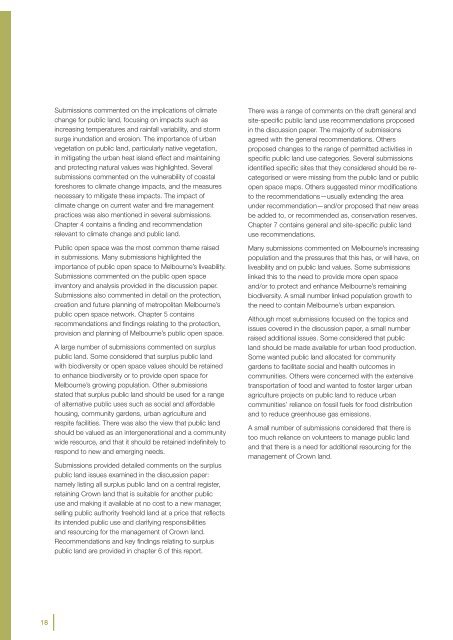Metropolitan Melbourne Investigation - Victorian Environmental ...
Metropolitan Melbourne Investigation - Victorian Environmental ...
Metropolitan Melbourne Investigation - Victorian Environmental ...
You also want an ePaper? Increase the reach of your titles
YUMPU automatically turns print PDFs into web optimized ePapers that Google loves.
Submissions commented on the implications of climate<br />
change for public land, focusing on impacts such as<br />
increasing temperatures and rainfall variability, and storm<br />
surge inundation and erosion. The importance of urban<br />
vegetation on public land, particularly native vegetation,<br />
in mitigating the urban heat island effect and maintaining<br />
and protecting natural values was highlighted. Several<br />
submissions commented on the vulnerability of coastal<br />
foreshores to climate change impacts, and the measures<br />
necessary to mitigate these impacts. The impact of<br />
climate change on current water and fire management<br />
practices was also mentioned in several submissions.<br />
Chapter 4 contains a finding and recommendation<br />
relevant to climate change and public land.<br />
Public open space was the most common theme raised<br />
in submissions. Many submissions highlighted the<br />
importance of public open space to <strong>Melbourne</strong>’s liveability.<br />
Submissions commented on the public open space<br />
inventory and analysis provided in the discussion paper.<br />
Submissions also commented in detail on the protection,<br />
creation and future planning of metropolitan <strong>Melbourne</strong>’s<br />
public open space network. Chapter 5 contains<br />
recommendations and findings relating to the protection,<br />
provision and planning of <strong>Melbourne</strong>’s public open space.<br />
A large number of submissions commented on surplus<br />
public land. Some considered that surplus public land<br />
with biodiversity or open space values should be retained<br />
to enhance biodiversity or to provide open space for<br />
<strong>Melbourne</strong>’s growing population. Other submissions<br />
stated that surplus public land should be used for a range<br />
of alternative public uses such as social and affordable<br />
housing, community gardens, urban agriculture and<br />
respite facilities. There was also the view that public land<br />
should be valued as an intergenerational and a community<br />
wide resource, and that it should be retained indefinitely to<br />
respond to new and emerging needs.<br />
Submissions provided detailed comments on the surplus<br />
public land issues examined in the discussion paper:<br />
namely listing all surplus public land on a central register,<br />
retaining Crown land that is suitable for another public<br />
use and making it available at no cost to a new manager,<br />
selling public authority freehold land at a price that reflects<br />
its intended public use and clarifying responsibilities<br />
and resourcing for the management of Crown land.<br />
Recommendations and key findings relating to surplus<br />
public land are provided in chapter 6 of this report.<br />
There was a range of comments on the draft general and<br />
site-specific public land use recommendations proposed<br />
in the discussion paper. The majority of submissions<br />
agreed with the general recommendations. Others<br />
proposed changes to the range of permitted activities in<br />
specific public land use categories. Several submissions<br />
identified specific sites that they considered should be recategorised<br />
or were missing from the public land or public<br />
open space maps. Others suggested minor modifications<br />
to the recommendations—usually extending the area<br />
under recommendation—and/or proposed that new areas<br />
be added to, or recommended as, conservation reserves.<br />
Chapter 7 contains general and site-specific public land<br />
use recommendations.<br />
Many submissions commented on <strong>Melbourne</strong>’s increasing<br />
population and the pressures that this has, or will have, on<br />
liveability and on public land values. Some submissions<br />
linked this to the need to provide more open space<br />
and/or to protect and enhance <strong>Melbourne</strong>’s remaining<br />
biodiversity. A small number linked population growth to<br />
the need to contain <strong>Melbourne</strong>’s urban expansion.<br />
Although most submissions focused on the topics and<br />
issues covered in the discussion paper, a small number<br />
raised additional issues. Some considered that public<br />
land should be made available for urban food production.<br />
Some wanted public land allocated for community<br />
gardens to facilitate social and health outcomes in<br />
communities. Others were concerned with the extensive<br />
transportation of food and wanted to foster larger urban<br />
agriculture projects on public land to reduce urban<br />
communities’ reliance on fossil fuels for food distribution<br />
and to reduce greenhouse gas emissions.<br />
A small number of submissions considered that there is<br />
too much reliance on volunteers to manage public land<br />
and that there is a need for additional resourcing for the<br />
management of Crown land.<br />
18
















